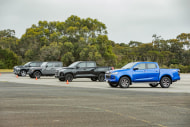
Do you need a 4x4 ute?
How often are you going to encounter situations where you need four-wheel drive?
How often are you going to encounter situations where you need four-wheel drive?
No, seriously. Be honest with yourself. Daily? You should definitely buy a 4x4 ute.
Weekly? You should probably buy a 4x4 ute.
Less than that? You’re right to be questioning whether you really, really need a four-wheel-drive vehicle, because there are significant reasons why you shouldn’t buy one.
- 4x4 models typically use more fuel
- They usually cost significantly more
- But they are also more in demand, and should hold their value better as a result

Let’s start with the biggest stumbling block first - price. Choosing a 4x4 ute will cost you significantly more than if you choose a 4x2 (rear-wheel drive) rig. We’re talking in the order of thousands of dollars.
In fact, here is a guide to the additional cost you’ll have to pay for each of the following utes if you choose 4x4 over 4x2 in the equivalent spec and body style:
- Ford Ranger - between $7200 - $11100
- Toyota HiLux - between $3480 - $6630
- Isuzu D-Max - $8000
- Mitsubishi Triton - between $4250 - $6750
- Nissan Navara - $7000
- Mazda BT-50 - between $6370 - $7770
- GWM Ute - $3000
Beyond the bucks, there are other considerations you will need to consider: choosing a 4x4 ute will cost you more to run… oh, so it is about the bucks.
Let’s now look at those same utes, and the difference between the official combined cycle fuel consumption figures for 4x2 vs 4x4 in like-for-like body and engine combos:
- Ford Ranger: 4x2 - 6.9L/100km; 4x4 - 7.2L/100km
- Toyota HiLux: 4x2 - 8.1L/100km; 4x4 - 8.4L/100km
- Isuzu D-Max: 4x2 - 7.7L/100km; 4x4 - 8.0L/100km
- Mitsubishi Triton: 4x2 - 8.4L/100km; 4x4 - 8.6L/100km
- Nissan Navara: 4x2 - 7.6L/100km; 4x4 - 7.9L/100km
- Mazda BT-50: 4x2 - 7.7L/100km; 4x4 - 8.0L/100km
- GWM Ute: 4x2 - 8.3L/100km; 4x4 - 9.4L/100km
While the differentials admittedly seem small at a glance, the implication is that for every tank you fill up, you’ll get through it faster in a 4WD ute.
If you are considering a higher-spec 4x4 ute as an option, also take note that it might have more expensive tyres (a higher-specced all-terrain, for example), which will be more expensive to replace than a more entry-level tyre, in most instances.
The other consideration you should keep in mind is that 4x4 utes are heavier.

Take a HiLux SR5 dual-cab 4x2 vs the same ute in 4x4 spec. The 4x2 model has a listed kerb weight of 1958kg, while the equivalent (3.0L diesel, auto, pick-up) SR5 4x4 tips the scales at 2110kg.
That doesn’t just mean it’ll cost more to run (see above), but it also means you have less usable payload to play with. The 4x4 HiLux SR5 dual-cab pick-up auto has a 940kg payload, while the 4x2 version is rated to 1022kg.
That could mean the difference between legally getting all your gear to a worksite, or having to leave something behind. I know, most tradies don’t check at a weighbridge before they continue on their way, but the penalties for travelling overweight can be significant - up to $3300 in some jurisdictions.
There are positive sides to 4x4 utes when compared to 4x2 examples, though.
A ute with four-wheel drive will inevitably be more capable and go more places than any 4x2 version would. You need only park a 4x2 ute on a grassy downhill slope and then try to reverse out of there to realise that - particularly unladen - these vehicles can get stuck very easily.
A 4x4 ute also offers better peace of mind that you won’t get stuck, or at least shouldn’t get stuck anywhere near as dramatically, should you need to or decide to venture off the beaten path.
And beyond all of that, the resale value for a 4x4 ute will typically be better than for a 4x2, and there will continue to be significantly more buyers in the market for used 4WD utes, too.
You might pay more to begin with, not to mention paying more to own and run your 4x4 ute, but you could end up losing less on it in the long run. Just remember that in most cases, if you highly accessorise your ute to suit your needs, those costs will be harder to recoup. Many shoppers prefer not to buy a canvas that has already been painted on.

More Tradie Ute Guide


